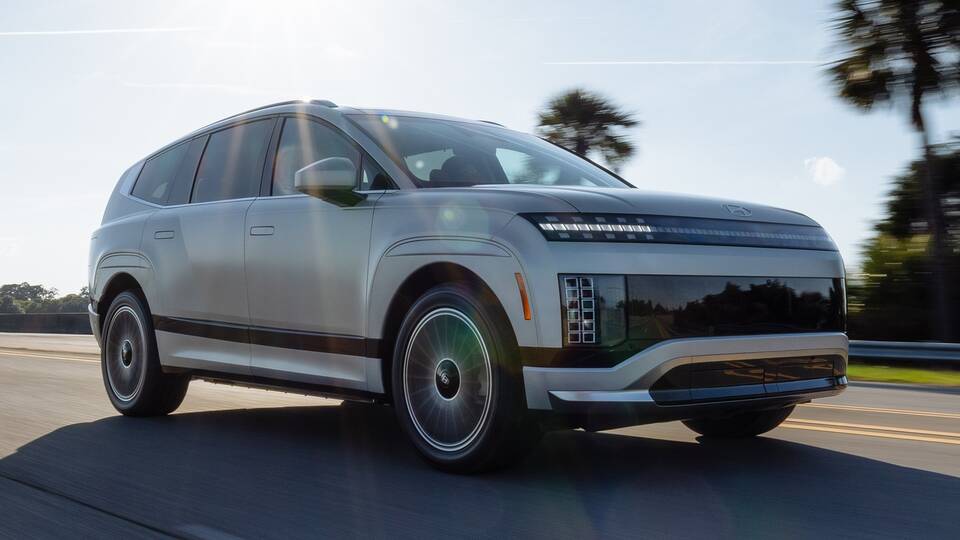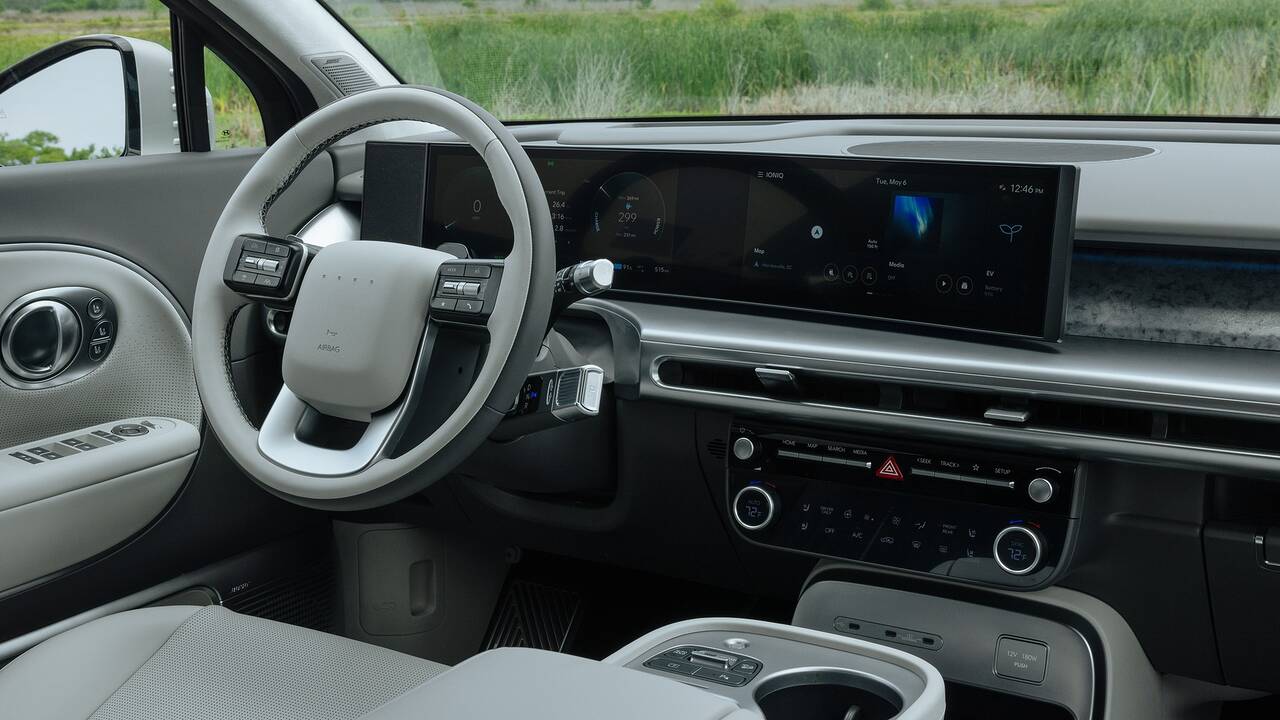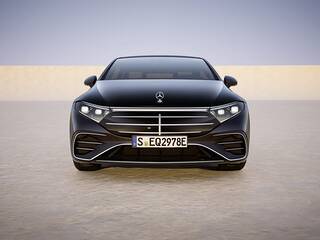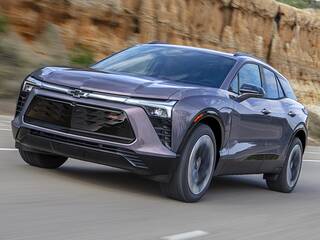The 335-mile 2026 Hyundai Ioniq 9 RWD has sloth-like acceleration for an EV
The one with the longest range is definitely not the one you want.

published May 26, 2025 | updated Jun 2, 2025

Key Takeaways
- The rear-wheel-drive Ioniq 9 maximizes range and affordability, but it also minimizes acceleration in a turn-back-the-clock kind of way.
- While the Ioniq 9 RWD gives Hyundai a bigger range number and a sub-$60,000 starting price to talk about, it's unlikely to delight actual customers.
Better get used to claims like "up to 335 miles of range" in Hyundai's ads for the all-new 2026 Ioniq 9. That figure is indeed the range ceiling for the Ioniq 9 lineup, and to be fair, it's quite impressive for a hefty three-row electric SUV, matching the far pricier Tesla Model X, for example.
But here's what Hyundai won't tell you, unless you're reading the fine print: the rear-wheel-drive Ioniq 9 — the one with the 335-mile rating — is the slowest variant in the lineup by a wide margin. It's also only offered in the base S trim level, which forces you to accept manual adjustments for the front passenger seat, among other indignities.
Just like its Kia EV9 cousin, then, the Ioniq 9 achieves its best range in a specification that no one should actually buy.
I thought Hyundai might treat the EV9 as a cautionary tale in this regard, and as it turns out, I was quite wrong.
Shared platform, shared compromises
The Ioniq 9 shares its E-GMP platform with the three-row EV9, but there are some subtle powertrain differences to be aware of. Most notably, the EV9 offers two RWD variants, one featuring a "Standard Range" 76.1-kWh battery that has no Ioniq 9 equivalent, the other boasting a larger "Long Range" 99.8-kWh battery that's also used in every all-wheel-drive EV9.
The Ioniq 9, meanwhile, employs the same 110.3-kWh battery whether you get RWD or AWD. That slight edge in battery size versus the 99.8-kWh EV9 explains the Hyundai's superior range estimates across the board.
So far, so straightforward. Here's where it gets weird.

If you want the EV9's top range estimate of 304 miles, you'll need the Long Range RWD configuration, which requires a massive compromise in the acceleration department that hardly anyone is talking about. To wit, even the good folks at Car and Driver continue to parrot Kia's press materials, asserting recently that the EV9's "claimed range of up to 304 miles make[s] it a compelling choice."
Sorry, no. That's a win for Kia PR, not actual shoppers. The EV9 with 304 miles of range — the Long Range RWD — isn't remotely compelling, because its 0-60 time of 8.8 seconds makes it just about the slowest electric vehicle on the market, while you can get the dramatically quicker EV9 Long Range AWD with 280 miles of range for just four grand more.
Now, I figured Hyundai might want to take a mulligan on this strategy with the Ioniq 9, since it's not a good look for the longest-range variant to have such a serious asterisk next to its name. But Hyundai seems to have concluded that the extra marketing juice is worth the awkwardness. Like the EV9 Long Range RWD, the Ioniq 9 RWD has longest range in the lineup, yet its profound lack of power and insignificant price advantage render it a rather unserious $60,000 electric SUV.
How slow is the 2026 Ioniq 9 RWD? Slower than you think.
Buried in a footnote in a Hyundai press release, you'll find the uncomfortable truth about the Ioniq 9 RWD's acceleration. Hyundai admits here that you'll need to allow 8.4 seconds to reach 60 mph from rest.
That would have been pretty good for a three-row gas SUV about 20 years ago, but by current EV standards, it's positively glacial. One of the distinguishing traits of today's EVs is how quickly they accelerate, and if you get an Ioniq 9 RWD, you're completely giving up that advantage.
Remember, we're talking about an SUV with premium pretensions that stickers at $58,995. Can you guess how many other electric SUVs accelerate this poorly? Having scoured our proprietary vehicle data, I count exactly one, unless you want to talk about the barely breathing Fiat 500e:
The Kia EV9 Long Range RWD, which does the deed in 8.8 seconds, as noted, and carries an MSRP of $59,900 for 2025.

Seriously, every other electric SUV will lay waste to the Ioniq 9 RWD when the light turns green. Even the subcompact Kia Niro EV ($39,600) hits 60 in 6.7 seconds, for goodness' sake.
How about a generic three-row gas crossover like the Honda Pilot? Try 0-60 in 7.2 seconds for the AWD version, which isn't even that great for the segment.
That Pilot driver can put the rear-drive Ioniq 9 in their rearview whenever the mood strikes, and Honda will only charge you $42,300 to get your foot in the door, or $40,200 if you're cool with front-wheel drive.
Another way to look at it is, the nearly $60,000 Ioniq 9 RWD is a nice option if you miss how large SUVs accelerated to 60 mph during the first Bush-Cheney administration. The Hyundai would have fared well in that comparison test, trailing ye olde Suburban (8.1 seconds) and Tahoe (8.2 seconds) but handily beating the Expedition and the Sequoia.
But if you're expecting anything like the sprightly EV acceleration you've heard about in today's reviews, the Ioniq 9 RWD ain't it.
How does the Ioniq 9 AWD compare vs. RWD?
Here's where the the rear-drive Ioniq 9's primary role as a marketing gimmick becomes abundantly clear. If the AWD variants were only marginally quicker, or if they were far quicker but also cost a lot more, then maybe a case could be made for the Ioniq 9 RWD's value proposition.
But in fact, the cheapest Ioniq 5 AWD only carries a $3,770 premium, starting at $62,765, and it adds 88 horsepower and a whopping 188 pound-feet of torque while sacrificing just 15 miles of range.
The extra power and torque transform the Ioniq 9's acceleration, as you might imagine, canceling that embarrassing 8.4-second run to 60 and replacing it with a wholly respectable 6.2-second sprint.
You also get the SE equipment package for your extra $3,770, stepping up from the RWD model's base S package, which is the only RWD trim offered. That nets you a standard power front passenger seat, as well as power lumbar adjustments for that seat.
Want the same AWD powertrain with more features? The SEL ($66,320) throws in a surround-view camera, parking sensors, ventilated front seats, heated second-row seats, a heated steering wheel and an auto-dimming rearview mirror with HomeLink. Or you could go whole hog with the Limited ($71,250) or Calligraphy ($74,990), which escalate the luxuries while also upping the performance ante to 422 horsepower (from 303 hp) and a sizzling 4.9-second sprint to 60.
2026 Hyundai Ioniq 9 Versions: Price, Range, Power & Acceleration
Vehicle Base MSRP Range Power 0‑60 2026 Ioniq 9 RWD $58,995 335 mi 215 hp 8.4 sec 2026 Ioniq 9 AWD Standard Output (SE/SEL) $62,735 320 mi 303 hp 6.2 sec 2026 Ioniq 9 AWD High Output (Limited/Calligraphy) $71,250 311 mi 422 hp 4.9 sec
Boiling it down to the three available powertrains, you can see just how close the RWD and the standard-output AWD versions are in price and range, despite the enormous gaps in power and acceleration.
It all begs the question: why would anyone choose the Ioniq 9 RWD, given how little money you'd save and how much you'd be giving up?
The best answer, I think, is that it's more for the marketing team than for real consumers, enabling seductive phrases like "starts under $60,000" and "335-mile range" to be strategically deployed.
MotorDonkey says
It's too bad that the Ioniq 9 RWD is impossible to recommend, because I'm otherwise pretty stoked about this new arrival. In fact, the Ioniq 9 is our fourth-ranked Large 3-Row Electric SUV right off the bat, edging out the EV9 primarily because of its higher range estimates.
In particular, the standard-output Ioniq 9 AWD (SE or SEL trim) hits the sweet spot with its 320-mile range, strong acceleration and plentiful features. Meanwhile, the high-output AWD version (Limited or Calligraphy trim) offers a genuine alternative to more expensive electric SUVs like the Rivian R1S and the Lucid Gravity.
So if we pretend that the Ioniq 9 RWD doesn't exist, there's not much to complain about here, and plenty to celebrate.
Just don't get dazzled by that 335-mile range, because you'll be paying luxury money for SUV performance straight out of the 2000s. ⛐ md

by Josh Sadlier
Publisher and Donkey-in-Chief
Josh has been reviewing cars professionally since joining Edmunds.com fresh out of grad school in 2008. Prior to founding MotorDonkey, he spent 15 years shaping Edmunds' expert automotive content in various capacities, starting as an associate editor and ultimately serving as a senior editor before wrapping up with a five-year term as the company's first-ever director of content strategy. Josh is a card-carrying member of the Motor Press Guild and a lifelong car nut who has driven, compared and critiqued thousands of cars in his career. Helping people find their perfect car never gets old—seriously!
 Let's make it official!
Let's make it official!
Be a good donkey and we'll deliver delicious car news straight to your inbox, spam-free forever.


